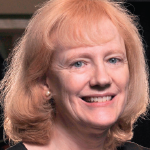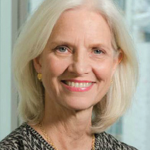
De Repente / shutterstock.com
When Marilynn “Lynn” Punaro, MD, MACR, isn’t working with medical students, seeing patients in the clinic, participating in translational research or performing leadership duties, she’s enjoying a good book—especially a good mystery.
This shouldn’t be a surprise. It was mystery that led Dr. Punaro to a career in pediatric rheumatology more than 30 years ago, at a time when there were only nine pediatric rheumatology fellowships in the country.
“Rheumatologists are the individuals who get called in to solve the complicated cases, when no one else knows what’s going on,” she says. “I enjoyed solving the mystery.”
Today, Dr. Punaro is medical director of rheumatology at Texas Scottish Rite Hospital for Children and a professor of pediatrics, division director of pediatric rheumatology, associate program director of the rheumatology fellowship, and Master of Fashena College (an academic college) at University of Texas Southwestern (UT Southwestern) Medical Center in Dallas.
ARHP Roles
Until recently, Dr. Punaro was also on the ACR Board of Directors. During that time, she served as the Board liaison to the ARHP Executive Committee. Currently, she serves as the only physician on the ARHP Membership and Nominations Committee.
Referring to her time on the Board, Dr. Punaro says, “I got to really see the depth and breadth of what ARHP does.”
Her respect for the health professional division traces back to the earliest days of her career. “When I was a pediatric rheumatology fellow [at UT Southwestern], I worked with a seasoned pediatric rheumatology physical therapist, Deanna Carman,” says Dr. Punaro. “She taught me a lot, and she was involved in ARHP.”
Early on, Ms. Carmen taught Dr. Punaro the value of the multiprofessional organization. The physical therapist would attend the annual ARHP meeting (which was, until about eight years ago, held in conjunction with, but separate from, the ACR Annual Meeting), sharing her own expertise and also learning from people who work around the world.
Staff Participation
“As I finished my training and became an academic pediatric rheumatologist, I supported and encouraged my ancillary staff to go to ARHP meetings and to become members,” says Dr. Punaro.

Dr. Punaro
This has benefitted her practice, she says, because many of her staff attend the ACR/ARHP Annual Meeting, where they network with other health professionals, attend sessions and bring back new knowledge.
It has been particularly fulfilling for Dr. Punaro to see how her staff have contributed to the rheumatology profession, particularly through efforts to help provide online education for ACR and ARHP members.
“Heather Benham, the nurse practitioner who works with me, is an exceptional person who has worked on the curriculum to help bring nurse practitioners up to speed if she (or he) is new to our subspecialty,” says Dr. Punaro. “That’s been fun to watch.”
Patients Win
Dr. Punaro’s patients have gained from her involvement with the ARHP, too.
“Engaging with ARHP, supporting staff with time off or money to take courses can improve the care you give your patients,” Dr. Punaro says. “The bottom line is always the patient. How can you do the best for your patients?”
Collaboration
Dr. Punaro says collaboration and shared knowledge have always been critical to her work. She has collaborated for most of her career with Virginia Pascual, MD, a pediatric rheumatologist and investigator at Weill Cornell Medicine, New York, engaging in research projects that have, in Dr. Punaro’s words, “changed how we’ve managed some pediatric diseases.”
For example, research they conducted together in the early 2000s showed that a pro-inflammatory molecule, interleukin 1, was a major factor in systemic juvenile arthritis. Using a drug already on the market that targeted interleukin 1, anakinra (Kineret), Drs. Punaro and Pascual showed they could vastly improve the health outcomes of pediatric patients.
Many kids are diagnosed with systemic juvenile arthritis before the age of 6, presenting with high fevers (103–105º) daily or a couple times a week, often with inflammation around their hearts or other organs.
“In the past, we would have had to use a lot of steroids—very toxic medications with a lot of side effects,” says Dr. Punaro. Now, she says, they start them on anakinra. “Within an hour, sometimes, they’re in the playroom. It’s really impressive. It’s almost like a light switch is flipped.”
“The discovery, which we reported in 2005, is one of the most rewarding aspects of my career,” Dr. Punaro says. This bench-to-bedside approach to rheumatology—being able to think about and study “what’s going on at the molecular and cellular level inside the patient,” and help bring targeted therapies to the bedside—drew her to the field.
‘Engaging with ARHP, supporting staff with time off or money to take courses, can improve the care you give your patients,’ Dr. Punaro says.
The Best Possible Care
These days, Dr. Punaro spends a lot of time mentoring medical students, especially women. When she first embarked on her career, she was one of 15 women in a class of 175. Now, women slightly outnumber men among medical school enrollees. Division chiefs still remain mostly male, which is likely to change as the profession ages and more women, such as Dr. Punaro, move into the ranks.
“I’ve been told I am a good role model,” she says. “I hope, if I am a role model, I am doing a good job with it. I’ve really loved what I do, and I think that’s what people don’t see about medicine. It’s a lot of work, but it really gives you more than it takes from you.”
Reflecting on how she and others can make “substantive changes” to advance the field, Dr. Punaro adds, “I think everyone plays a part in that, from the person at the front desk who greets patients, to the nurse at the bedside, the physical therapist, the scientist in the lab to the physician.”
It’s why she continues to support the ARHP and hopes to see membership in the organization grow. “I think the more we can excel in our mission, the more we can each bring our best to that, the more we will excel as a team and bring the best possible patient care.”
Kelly April Tyrrell writes about health, science and health policy. She lives in Madison, Wis.

